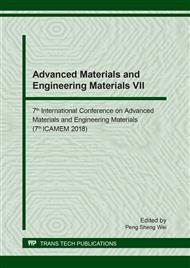p.543
p.548
p.554
p.559
p.564
p.569
p.577
p.582
p.587
Effect of Control Technology on Properties of Quartz Porous Brick
Abstract:
A high-performance quartz sand insulation brick was prepared by using low grade quartz sand under different sintering process conditions. The optimum sintering process conditions were obtained by analyzing the relationship between microstructure and sintering process. Through the compounding, pulping, forming, drying and sintering processes, and the performance test of the porous brick, the following conclusions can be drawn, the comprehensive performance in all aspects, the porosity is similar, the preferred high compressive strength conditions, in order to get a best The bonding point, brick body sintering temperature of 1150 °C, porosity of 74.56%, compressive strength of 2.1 MPa of porous brick, and the pores are smooth, more uniform distribution. With the prolonging of the holding time, the porosity of the porous brick is reduced, and the performance is 1h, the porosity is 77.22% and the compressive strength is 2.05 MPa. When the raw material ratio is 60% quartz sand, 30wt% kaolin, calcium carbonate 9.6wt%, foaming agent 0.4wt%, water ratio 0.9 holding time at 1h sintering at 1150°C can get better porosity and compressive strength of the insulation brick. The porous material was sintered at 1150 °C, the content of foaming agent was 0.2wt%, the ratio of water to material was 0.9, and the compressive pressure and porosity were the better.
Info:
Periodical:
Pages:
564-568
Citation:
Online since:
August 2018
Authors:
Keywords:
Price:
Сopyright:
© 2018 Trans Tech Publications Ltd. All Rights Reserved
Share:
Citation:


